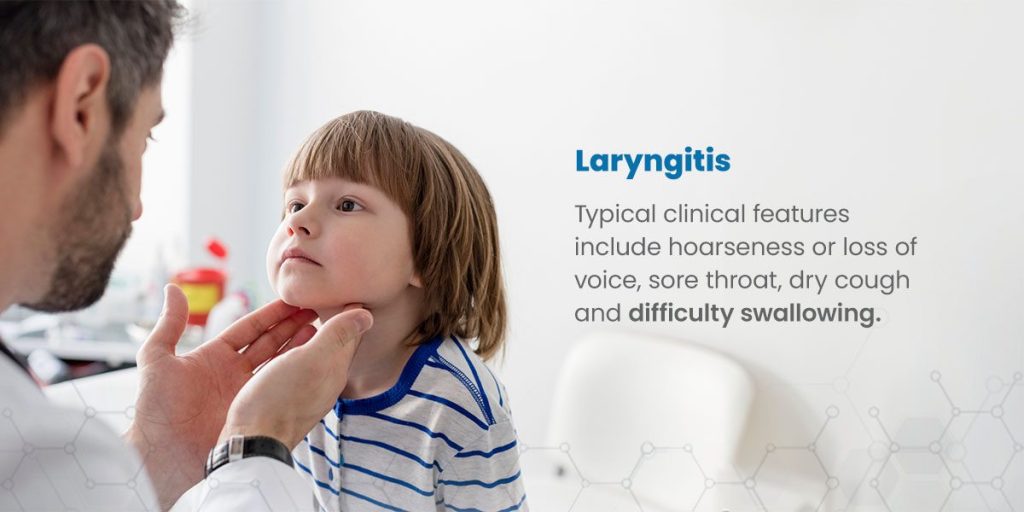As a medical professional, you play a vital role in pediatric health care. Recognizing the signs of respiratory infections in children is crucial for early therapeutic interventions. These infections — like the common cold — typically share many symptoms. As a result, each respiratory infection requires careful observation and assessment.
This guide explores seven prevalent respiratory infections in kids so you can deliver more timely and effective therapeutic interventions.
What Is a Respiratory Infection?
A respiratory tract infection (RTI) is an infectious disease affecting the respiratory system. This network of organs and tissues includes the nose, throat, sinuses, airways and lungs. RTIs can be caused by viral or bacterial pathogens.
An RTI can manifest as upper respiratory infections (URIs) or lower respiratory infections (LRIs). URIs involve the nose, throat and sinuses, leading to possible symptoms like nasal congestion, sore throat, coughing and sneezing. On the other hand, LRIs affect the airways and lungs. They result in symptoms like breathing difficulties, chest congestion, productive cough and fever.
Symptoms of respiratory infections in children can progress rapidly and lead to more severe complications. This is particularly true in infants and young children with immunocompromised systems.
7 Prevalent Upper Respiratory Infections in Children
This list clarifies the subtle differences between each condition. We’ll specifically dive into their characteristics and clinical manifestations.
1. Common Cold
The common cold — although typically harmless — remains a burden for most. Individuals may experience nasal congestion, coughing, sneezing and a sore throat. It’s caused by rhinoviruses, but the adenovirus or respiratory syncytial virus (RSV) can also be a contributor.
Although there’s no cure, the infection is usually self-limiting and resolves within a week or two without specific therapeutic interventions. However, that doesn’t stop it from spreading. Colds spread easily in enclosed spaces like classrooms, workplaces and homes. Colder seasons and age are also risk factors.
Children frequently catch colds — and that’s normal. Adults may experience two to four colds, whereas young children may experience up to 10 colds yearly before they turn 2.
A sore throat is generally the first symptom of a cold, and a runny or congested nose follows shortly after. Children may also present with a fever, slight headache and decreased appetite.
2. Influenza
The flu — like the common cold — is highly contagious. The two share similar clinical manifestations but have one key difference. The etiology of the flu is an influenza virus, whereas viral pathogens are the agents responsible for a cold.
Children are more at risk of catching the flu due to their lack of prior immunity or exposure to the viral infection. Between 2021 and 2022, the amount of flu cases was more prominent in children than adults.
Influenza clinical features are typically more adverse than common cold symptoms. Individuals may experience a sudden onset of flu symptoms. These include high fever, chills, severe muscle aches, headache, sore throat, coughing and fatigue. Gastrointestinal symptoms like nausea, vomiting and diarrhea may also manifest in children.
3. Sinusitis
Sinusitis, or rhinosinusitis, is one of the most frequent causes of clinical visits. A sinus infection is an inflammation or swelling of the lining of the sinus cavities. The primary etiology of viral sinusitis is the common cold.
Additional factors include other viral and bacterial pathogens and allergens. Those with immunocompromised systems and structural problems within the sinuses are at higher risk for developing sinusitis.
Prevalent sinus infection symptoms include nasal congestion, thick nasal discharge, facial pain or pressure, coughing, headaches and post-nasal drip. Children may also exhibit irritability, fatigue and difficulty feeding.
4. Laryngitis
Laryngitis is an inflammation of the larynx, which can be acute or chronic. Most cases of acute laryngitis are minor and self-limiting, persisting three to seven days on average. Chronic laryngitis is when the illness persists for more than three weeks.
Viral infections that cause URIs are the most frequent cause of acute laryngitis. Other etiologies include bacterial and candida infections and temporary vocal strain. Acute laryngitis is infectious and may present in varying degrees of severity.
Typical clinical features include hoarseness or loss of voice, sore throat, dry cough and difficulty swallowing. In severe cases, a child may experience a fever or difficulty breathing.

5. Pharyngitis
Otherwise known as a sore throat, Pharyngitis is inflammation of the pharynx. Viral infections like the common cold or flu can cause it. Other pharyngitis etiologies include allergens, bacteria group A strep, varicella (chickenpox) and croup.
Note that the symptoms experienced depend on the etiology. Common viral pharyngitis symptoms include voice hoarseness, coughing, rhinitis and conjunctivitis. If strep throat is responsible, individuals may experience fever, throat pain, swelling and redness and swollen lymph nodes.
6. Tonsillitis
Tonsillitis is an inflammation caused by an infection of the tonsils, the two lymph nodes located at the back of the throat. It’s caused by viral pathogens like the common cold or flu. That said, bacterial infections like strep throat can also be responsible.
Children are most affected by tonsillitis, and those between the ages of 5 and 15 are at a greater risk. Frequent germ exposure, like in schools, can also cause tonsillitis.
The first clinical manifestation of tonsillitis is a sudden sore throat. Other possible symptoms, like pain or difficulty swallowing, fever and swollen and red tonsils, may follow. Occasionally, white patches or pus on the tonsils may manifest.
In severe cases, the neck may have swollen and painful glands. Children may also experience nausea, vomiting and stomachaches.
7. Croup
Croup is a prevalent respiratory illness affecting children under 5. Croup causes the airway to constrict and becomes more difficult to breathe. It’s characterized by inflammation of the larynx, trachea and bronchi.
Viral infections usually cause croup, commonly parainfluenza virus types 1 and 2. General clinical features include a “seal-like” barking cough, stridor, hoarseness and difficulty breathing. These symptoms often exacerbate at night.
Other clinical manifestations may include low-grade fever and respiratory distress. Severe cases may need hospitalization for observation and management.
Preventing Respiratory Infections in Children
Children’s respiratory infections can be prevented with a multimodal strategy. These strategies must help boost immunity and lower germ exposure. Here are general URI preventive measures:
- Frequent handwashing: Teach children why, when and how to wash their hands. For instance, always use soap and wash hands before eating and after using the bathroom.
- Respiratory etiquette: Teach children to cover their mouths and noses with a tissue or elbow when coughing or sneezing.
- Respiratory hygiene: Advise children to avoid touching their face with unwashed hands to prevent germ exposure and distribution.
- Promote vaccination: Ensure children receive recommended vaccines for influenza and other prevalent RTIs. They must build immunity and reduce their risk of infection.
- Maintain cleanliness: Keep commonly touched surfaces clean and disinfected. A clean environment may minimize the presence of viral and bacterial pathogens.
- Healthy habits: Promote a balanced diet, regular exercise and adequate sleep to support a strong immune system and health outcomes.
- Limit exposure: Avoid close contact with people with RTIs to reduce the risk of transmission.
- Support breastfeeding: If possible, encourage breastfeeding infants, as breast milk provides antibodies that can help protect against some respiratory infections.
Therapeutic Interventions for Respiratory Infections In Children
Therapeutic interventions for respiratory infections in children integrate a combination of supportive care, symptomatic relief and, in some cases, specific antiviral or antibiotic therapy. Here are general URI therapeutic interventions:
- Fluid intake: Encourage children to drink water, juice or broth to stay hydrated. Hydration helps loosen mucus and soothe the throat.
- Warm liquids: Serve warm beverages like tea with honey or soup to ease throat irritation and provide comfort. Note — you should avoid feeding children honey until they are at least 12 months of age, as it can result in botulism.
- Adequate rest: Allow children to rest and get plenty of sleep. Adequate rest helps their bodies fight infections and increases the chances of a faster recovery.
- Use medications: Provide age-appropriate medications to alleviate fever and discomfort. Parents must follow dosage instructions carefully.
- Air humidifying: Encourage caretakers to use a cool-mist humidifier or have them sit with the child in a steamy bathroom. Moistened air can help ease congestion and coughing.
- Use nasal drops: Use saline drops or sprays to help clear nasal passages and relieve congestion. Nasal drops help younger children who cannot blow their noses effectively.
- Medical attention: Prompt medical evaluation and therapeutic intervention are recommended if symptoms exacerbate or persist or if the child experiences difficulty breathing.

Leverage Applied BioCode Inc.’s Advanced Diagnostic Solution
Recognizing and understanding the typical signs and symptoms of respiratory infections in children is crucial for early intervention and effective management. To explore cutting-edge solutions for respiratory infection diagnostics, consider partnering with Applied BioCode Inc.
Laboratories, hospitals and universities can benefit from the BioCode® Respiratory Pathogen Panel. This advanced panel offers high-throughput capabilities, helping simultaneously detect and identify multiple pathogens from a single sample.
This panel streamlines the diagnostic process with features like data masking and efficient processing. As a result, tools like these can improve patient therapeutic interventions and outcomes.
Contact us online today for further inquiries.


